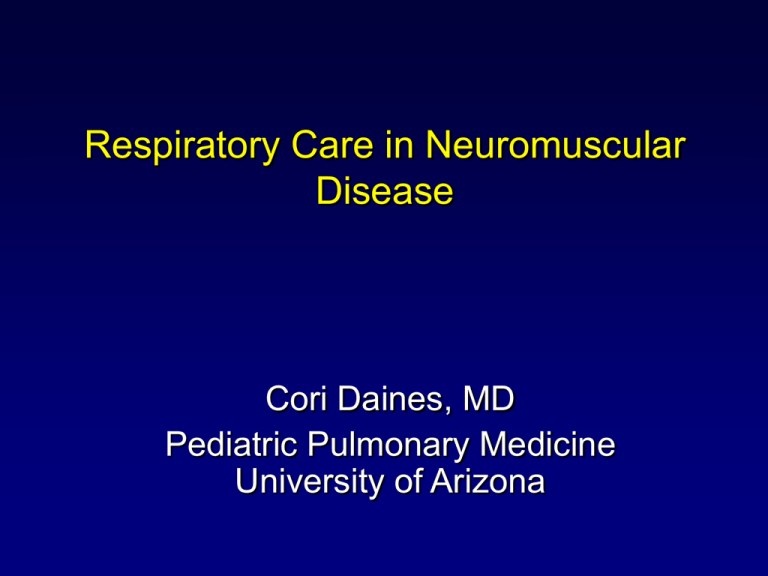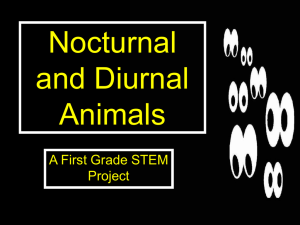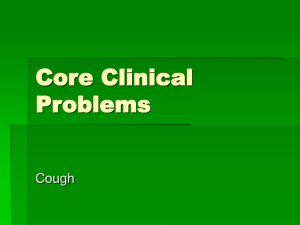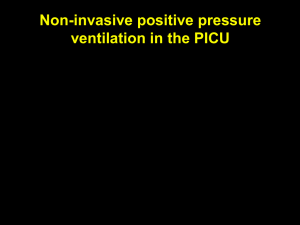Rings, Slings, and other things that squish on kids` airways and
advertisement

Respiratory Care in Neuromuscular Disease Cori Daines, MD Pediatric Pulmonary Medicine University of Arizona Neuromuscular Disease • • • • • Duchenne’s muscular dystrophy Becker’s muscular dystrophy Limb-Girdle muscular dystrophy Spinal muscular atrophy Myotonic dystrophy Neuromuscular Disease • Genetically inherited • Muscle weakness – Extremities – Trunk/spine – Respiratory – Swallowing – Cardiac Neuromuscular disease • Controller failure • Chest wall compromise • Muscle weakness – Hypotonia – Hypertonia Respiratory Control • Maintain homeostasis – Oxygen – Carbon dioxide – Hydrogen ion concentration (pH) • Optimize mechanical efficiency • Complex functions – – – – Vocalization Cough Exercise Adaptation to disease Respiratory Muscles • • • • • • • Diaphragm Intercostals Accessory muscles (shoulder girdle) Pharynx Larynx Abdominal wall Perineum Physiologic impact • • • • • • • • Ventilatory impairment Oxygenation impairment [(A-a)DO2 ] Sleep disordered breathing Maintenance of lung volume Growth of the lung in children Lung clearance impairment Lung inflammation from aspiration Nocturnal vs diurnal dysfunction varies Prevention • Assuming that there is no primary lung disease most NMD patients can have normal lungs • “An ounce of prevention is worth a pound of cure” • 4 E’s = “Expansion, Evacuation, Evasion and Evaluation” – i.e. expand the lungs, clear the airways, and avoid aspiration and infection – Evaluate how the patient progresses acutely and over the long term Minimize work of breathing • Normally 15% of energy = WOB • In NMD this can be exceeded – Decreased use of energy in movement – Increased work of breathing due to inefficient system and/or stiff/obstructed lungs • Increased WOB will lead to chronic hypercapnea and compensatory alkalosis Expansion • Weakness leads to – Poor inspiration – Atelectasis and decreased compliance due to fluid accumulation and microatelectasis – Chest wall/Shoulder girdle contracture – Kyphoscoliosis (except DMD) • Loss of MIP correlates with loss of lung volume and MIP < 30 are predictive of increases in CO2 Duchenne MD: FVC vs Age Bach et al. Arch Phys Med Rehabil 1981; 62:328 Expansion • Reduced: TLC, VC, FRC, ERV • Balance between chest wall and diaphragm – Affects optimal position (Upright better with weak diaphragm) – Rate of loss of function affects degree of breathing intolerance: Rapid is worse Evacuation • Optimal humidity and warmth to maintain ciliary function • Cough – Sense – Close glottis – Pressurize pulmonary gas by tensing abdomen and perineum (200 cm H2O) – Explosively open airway – Continue cough to lower lung volume • Cough peak flow transients are 6 to 12 liters per second; i.e. 360 to 720 L/min Pulmonary clearance failure • • • • Disrupted cilia due to drying and inflammation Low tidal volume (< 20 ml/kg) Poor glottic closure Poor abdominal compression – CPF < 2.7 L/sec = 160L/min predict failure of extubation in adults (i.e. < 2 L/min/kg) • Poor coordination • Inablility to continue to low lung volume Evacuation • • • • Chest physiotherapy Stacking with voluntary cough Stacking with augmented cough Mechanical insufflation-exsufflation Tracheostomy EVASION: Avoid pulmonary damage • Growth failure – Poor expansion – Poor nutrition • Aspiration • Foreign body (tracheostomy) • Poor clearance with inflammatory processes Evasion: Aspiration • A tension exists between natural, pleasure giving aspects of feeding and danger of aspiration and inadequate nutrition • Often this leads to an illogical approach; i.e. pt has to fail oral feeds to go to alternative as opposed to succeed with oral feedings to move off of supportive modalities (NG,GT etc) • Progresses early in SMA/Brainstem dysfunction and later in DMD • Oral hygiene important even if NPO Evaluation • History and physical including QOL and sleep questionnaire • Chest film • Lung volumes • MIP/MEP • Sniff MIP • Inspiratory flow reserve • Maximum insufflation capacity • Cough peak flows Patient status changes with viral respiratory infections • • • • • Increased secretions Decreased muscle strength Surfactant dysfunction in LRI Transient increase in need for support We commonly evaluate patients when they have recovered from an illness or are stable Dr. Bach: Outpatient Protocol • Patients at risk – During chest colds w/ assisted PCF below 270 LPM • Patients prescribed – Oximeter and MIE device • Patients trained in – Air stacking insufflated volumes via mouth and nasal interfaces – Manually assisted coughing – Mechanical in-exsufflation at [+35 to +50] to [-35 to -50] cm H2O Outpatient Protocol • Patients given 1-hour access to – Portable volume ventilator – Cough Assist MIE (J. H. Emerson Co., Cambridge, MA) – Various mouthpieces and nasal interfaces • Patients and care providers are instructed – SaO2 <95% indicates hypoventilation or airway mucus accumulation that must be cleared to prevent atelectasis and pneumonia – Use SaO2 monitoring whenever fatigued, short of breath, or ill – Use noninvasive IPPV and manually and mechanically assisted coughing as needed to maintain normal SaO2 at all times Outpatient Protocol • Patients with elevated EtCO2 or daytime SaO2 <95% – Undergo nocturnal SaO2 monitoring • When symptomatic or nocturnal SaO2 mean <94% – A trial of nocturnal nasal IPPV is provided • People continue to use nocturnal nasal IPPV when they felt less fatigue and nocturnal mean SaO2 increases. • Most young patients use noninvasive IPPV for the first time to assist lung ventilation during chest infections. Respiratory muscle aids: Indications • Failure to maintain a healthy lung with growth and optimal ventilatory function – i.e. failing the 3 E’s • Prevention is key • Optimize support in relation to the needs of the patient Using what the patient has • Daytime spontaneous respiration with nocturnal support for control, airway obstruction, recruitment of lung volume • Glossopharyngeal breathing during the daytime with nocturnal ventilation • Optimizing cough and lung volume with stacking maneuvers Glossopharyngeal breathing Maximal insufflation capacity • Breath stacking • Measured unassisted with spontaneous breathes or GPB breaths • Commonly 1.5x the VC • Can be augmented with interface and manual resuscitator bag • Maintain lung volume and compliance and chest wall compliance Inspiratory muscle aids • Rocking bed and abdominal belt – Disadvantage is no expansion of lung; i.e. frc to less than frc • Negative pressure ventilators – Disadvantages are OSAS and aspiration • Non-invasive IPPV • Tracheostomy and IPPV Nocturnal support • Used prior to need for 24/7 support • Improves daytime PaO2, PaCO2 • Reduces respiratory muscle work at night and rests the muscles • Reverses cor pulmonale perhaps in addition to O2 by improving lung volume Nocturnal support • Increases MIP and lung volume • Improves compliance and FRC during the daytime • Can be used even in patients with severe breathing intolerance – CCHS or Quadraparesis with daytime diaphragmatic pacing – GPB during daytime • Can be transitioned to 24/7 with illnesses NIPPV: Interfaces • • • • Full face mask Nasal mask Custom mask Mouthpiece / Lipseal – Leakage and dental issues • Sipper mouthpiece NIPPV: Nasal mask / Prongs • 2-3 x preferred compared to mouthpiece • Problems: – Leak, esp mouth – Nasal bridge pressure with mask – Gum erosion or compression with mask – Nasal erosion with prongs • Chin strap may be needed NIPPV: Full face mask • Decreased leak • Decreased – Cough – Talking – Eating • Nocturnal use with daytime nasal mask NIPPV: Sipper / Mouthpiece • Daytime use • Allows facial freedom • Flexed mouthpiece +/- custom orthodontics • Intermittently used to augment breathing • Continuously used NIPPV: Sipper / Mouthpiece • Large VT set on ventilator or High insp flow if pressure controlled • Allows stacking maneuvers • Head/neck control for intermittent use • Use of flexed mouthpiece with a back pressure of 2-3 cmH2O can reduce low pressure/disconnect alarms Complications of NIPPV • • • • Facial and orthodontic changes Aerophagia (PIP > 25 cmH2O) Nasal drying/congestion = humidify Volutrauma - air leak Tracheostomy • Controversial • Current view in rehab circles is that with proper care a tracheostomy is never needed • Our experience is that tracheostomy may have a role – Patient preference – Upper airway dysfunction – Severe central airway obstruction by secretions Ventilators Ventilators • Pressure cycled vs Volume cycled • Pressure cycled are often triggered by flow sensing reducing work of breathing • Flow sensing is also important in pts with high respiratory rates = infants/toddlers Ventilators • Leak can vary with sleep, position, and effort which is problematic with volume cycled ventilators • Variable airway resistance and/or pulmonary or chest wall compliance better with volume settings • Pressure cycling limits ability to stack Ventilator triggering and rate • Small/weak or brainstem/CNS pts may not trigger well • Spontaneous-timed modes are useful with a backup rate higher than spontaneous when initiating ventilation in infants/young children • Back-up rates lower than spontaneous once comfortable • • • • • Ventilation goals Healthy lungs with good volumes and no atelectasis Rate on the low side and Vt or PIP on the high side PaCO2 = 35 ± 5 mmHg Room air Patient comfort – – – – Ability to trigger vent Ability to deliver needed volume/flow in time No auto-PEEP No auto-cycling / Ventilator-Patient dysynchrony • Primary lung disease may change this approach BiPAP settings • S/T mode / High span IPAP/EPAP – If OSAS is main issue low span is appropriate • IPAP range 15-18 – May need higher with high UA resistance, noncompliant lungs, obesity/non-compliant chest wall – May need to be lower with high spont rates • EPAP range 2-4 – Depending upon circuit may need 4 cmH2O to avoid rebreathing – High EPAP is rarely needed Other issues • Inspiratory time – I:E of 1:2 – Ti of 0.5 min (infant) and 1.0 (>infant) • Insp flow rate necessary to achieve pressure comfortably • Trigger sensitivity set to reduce WOB, but not autocycle • Pressure support may improve comfort with spontaneous breaths – Ultimately creates an S/T mode depending upon settings LTV system - Pulmonetics LTV system - Pulmonetics LTV system LTV: Features Control mode ventilation Limited respiratory control / Inability to trigger breaths Assist Control Mode Can trigger breaths, but needs support with each breath SIMV Mode Most patients, improved comfort, stable CO2s Bilevel Mode Mimic BiPAP / No Backup Rate Rise Time • Pressure control • Pressure support • Flow in volume control is set by Ti and Vt Rise Time • Slow rise time – Small ET – Bronchospasm / AOD – Pressure overshoot on PIP • Fast rise time – Short Ti / High respiratory rate • Vary with age; i.e. larger VT = faster rise time Home ventilation reality • Every patient is unique • These are “more guidelines rather than rules” • Vary settings, interfaces, strategies to achieve goals of good health and optimized quality of life Discharge home: Medical Issues • • • • • • Presence of a stable airway FiO2 less than 40% PCO2 safely maintained Nutritional intake optimal Other medical conditions well controlled Above may vary if palliative care Jardine E, Wallis C. Thorax 1998; 53:762 Discharge Home: Support • Goals and plans clarified with family and caregivers • Family and respite caregivers trained in the 4 E’s and all equipment • Nursing support arranged for nighttime • Equipment lists developed and implemented with re-supply and funding addressed • Funding and insurance issues addressed










